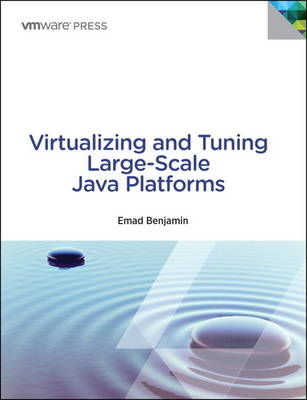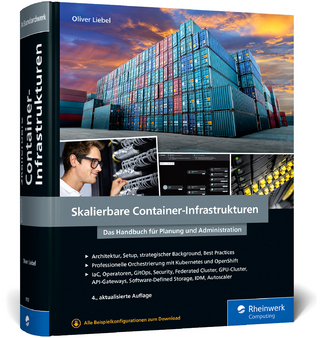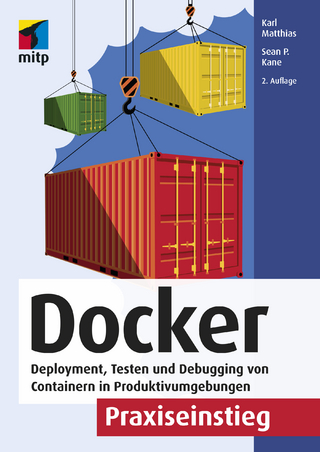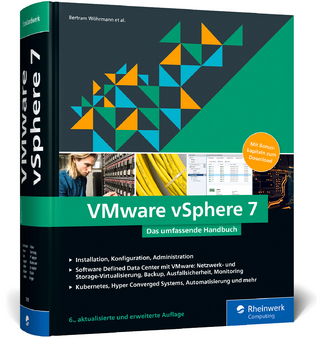
Virtualizing and Tuning Large Scale Java Platforms
VMWare Press (Verlag)
978-0-13-349120-3 (ISBN)
- Titel ist leider vergriffen;
keine Neuauflage - Artikel merken
Technical best practices and real-world tips for optimizing enterprise Java applications on VMware vSphere®
Enterprises no longer ask, “Can Java be virtualized”? Today, they ask, “Just how large can we scale virtualized Java application platforms, and just how efficiently can we tune them?” Now, the leading expert on Java virtualization answers these questions, offering detailed technical information you can apply in any production or QA/test environment.
Emad Benjamin has spent nine years virtualizing VMware’s own enterprise Java applications and working with nearly 300 leading VMware customers on projects of all types and sizes—from 100 JVMs to 10,000+, with heaps from 1GB to 360GB, and including massive big-data applications built on clustered JVMs. Reflecting all this experience, he shows you how to successfully size and tune any Java workload.
This reference and performance “cookbook” identifies high-value optimization opportunities that apply to physical environments, virtual environments, or both. You learn how to rationalize and scale existing Java infrastructure, modernize architecture for new applications, and systematically benchmark and improve every aspect of virtualized Java performance. Throughout, Benjamin offers real performance studies, specific advice, and “from-the-trenches” insights into monitoring and troubleshooting.
Coverage includes
--Performance issues associated with large-scale Java platforms, including consolidation, elasticity, and flexibility
--Technical considerations arising from theoretical and practical limits of Java platforms
--Building horizontal in-memory databases with VMware vFabric SQLFire to improve scalability and response times
--Tuning large-scale Java using throughput/parallel GC and Concurrent Mark and Sweep (CMS) techniques
--Designing and sizing a new virtualized Java environment
--Designing and sizing new large-scale Java platforms when migrating from physical to virtualized deployments
--Designing and sizing large-scale Java platforms for latency-sensitive in-memory databases
--Real-world performance studies: SQLFire vs. RDBMS, Spring-based Java web apps, vFabric SpringTrader, application tiers, data tiers, and more
--Performance differences between ESXi3, 4.1, and 5
--Best-practice considerations for each type of workload: architecture, performance, design, sizing, and high availability
--Identifying bottlenecks in the load balancer, web server, Java application server, or DB Server tiers
--Advanced vSphere Java performance troubleshooting with esxtop
--Performance FAQs: answers to specific questions enterprise customers have asked
Emad Benjamin has been in the IT industry for the past 20 years. He graduated with a Bachelor of Electrical Engineering degree from the University of Wollongong. Early in his career, he was a C++ software engineer. Then, in 1997, he took on his first major project using Java and has focused on Java ever since. For the past 8 years, his main concentration has been Java on VMware vSphere. Emad is a featured speaker at VMworld, Spring-One, UberConf, NFJS, and various other Java user groups around the world. Currently, Emad is a principal architect in the Global Center of Excellence focused on VMware virtualization, providing training and evangelism to various corners of the world.
Preface xv
Chapter 1 Introduction to Large-Scale Java Platforms 1
Large-Scale Java Platform Categories 1
Large-Scale Java Platform Trends and Requirements 2
Compute-Resource Consolidation 2
JVM Instance Consolidation 3
Elasticity and Flexibility 3
Performance 4
Large-Scale Java Platform Technical Considerations 4
Theoretical and Practical Limits of Java Platforms 4
NUMA 9
Most Common JVM Size Found in Production Environments 14
Horizontal Scaling Versus Vertical Scaling of JVMs and VMs 15
Summary 20
Chapter 2 Modern Scalable Data Platforms 21
SQLFire Topologies 24
Client/Server Topology 24
Peer-to-Peer Topology 27
Redundancy Zones 28
Global Multisite Topology 28
SQLFire Features 30
Server Groups 32
Partitioning 34
Redundancy 37
Colocation 38
Disk Persistence 39
Transactions 41
Cache Plug-In 46
Listeners 47
Writers 50
Asynchronous Listeners 52
DBSynchronizer 54
SQLF Commands and DDLUtils 57
Active-Active Architectures and Modern Data Platforms 57
Chapter Summary 61
Chapter 3 Tuning Large-Scale Java Platforms 63
GC Tuning Approach 70
Step A: Young Generation Tuning 71
Step B: Old Generation Tuning 76
Step C: Survivor Spaces Tuning 78
Chapter Summary 78
Chapter 4 Designing and Sizing Large-Scale Java Platforms 79
Designing and Sizing a New Environment for a Virtualized Large-Scale Java Platform 79
Step1: Establishing Your Current Production Load Profi le 80
Step 2: Establish a Benchmark 82
Step 3: Size the Production Environment 95
Sizing vFabric SQLFire Java Platforms: Category 2 Workloads 96
Step A: Determine Entity Groups 97
Step B: Determine the Memory Size of the Data Fabric 100
Step C: Establish Building Block VM and JVM Size and How Many vFabric SQLFire Members Are Needed 105
Understanding the Internal Memory Sections of HotSpot JVM 106
Understanding NUMA Implications on Sizing Large VMs and JVMs 108
vFabric SQLFire Sizing Example 112
Chapter Summary 119
Chapter 5 Performance Studies 121
SQLFire Versus RDBMS Performance Study 121
Performance Results 123
Summary of Findings 126
The Olio Workload on tc Server and vSphere Performance Study 127
Looking at the Results 127
SpringTrader Performance Study 131
Application and Data Tier vSphere Confi gurations 133
The SpringTrader Performance Study Results 137
Performance Differences Between ESXi 3, 4.1, and 5 139
CPU Scheduling Enhancements 140
Memory Enhancements 140
vSphere 5 Performance Enhancements 142
Chapter Summary 143
Chapter 6 Best Practices 145
Enterprise Java Applications on vSphere Best Practices (Category 1) 148
VM Sizing and Confi guration Best Practices 148
vCPU for VM Best Practices 149
VM Memory Size Best Practices 150
VM Timekeeping Best Practices 156
Vertical Scalability Best Practices 156
Horizontal Scalability, Clusters, and Pools Best Practices 158
Inter-Tier Confi guration Best Practices 160
High-Level vSphere Best Practices 165
SQLFire Best Practices and SQLFire on vSphere Best Practices (Category 2 JVM Workload Best Practices) 166
SQLFire Best Practices 168
vFabric SQLFire Best Practices on vSphere 173
Category 3 Workloads Best Practices 181
IBM JVM and Oracle jRockit JVMs 181
GC Policy Selection 184
IBM GC Choices 186
Oracle jRockit GC Policies 187
Chapter Summary 187
Chapter 7 Monitoring and Troubleshooting Primer 189
Open a Support-Request Ticket 191
Collecting Metrics from vCenter 191
Troubleshooting Techniques for vSphere with esxtop 195
Java Troubleshooting Primer 198
Troubleshooting Java Memory Problems 202
Troubleshooting Java Thread Contentions 203
Chapter Summary 204
Appendix FAQs 205
Glossary 229
Best Practices
Best Practice 1: Common Distributed Data Platform 24
Best Practice 2: Client/Server Topology 26
Best Practice 3: Peer-to-Peer Multihomed Machines 27
Best Practice 4: Multisite 29
Best Practice 5: Use Server Groups 33
Best Practice 6: Horizontal Partitioning 37
Best Practice 7: Redundancy 38
Best Practice 8: Colocation 38
Best Practice 9: Disk Persistence 40
Best Practice 10: Transactions 45
Best Practice 11: RowLoader 47
Best Practice 12: Listeners 49
Best Practice 13: Writers 51
Best Practice 14: Asynchronous Listeners 53
Best Practice 15: DBSynchronizer 55
Best Practice 16: VM Sizing and VM-to-JVM Ratio Through a Performance Load Test 149
Best Practice 17: VM vCPU CPU Overcommit 149
Best Practice 18: VM vCPU, Do Not Oversubscribe to CPU Cycles That You Don’t Really Need 150
Best Practice 19: VM Memory Sizing 152
Best Practice 20: Set Memory Reservation for VM Memory Needs 154
Best Practice 21: Use of Large Pages 154
Best Practice 22: Use an NTP Source 156
Best Practice 23: Hot Add or Remove CPU/Memory 157
Best Practice 24: Use vSphere Host Clusters 158
Best Practice 25: Use Resource Pools 159
Best Practice 26: Use Affi nity Rules 159
Best Practice 27: Use vSphere-Aware Load Balancers 160
Best Practice 28: Establish Appropriate Thread Ratios That Prevents Bottlenecks (HTTP threads:Java threads:DB Connections Ratio) 160
Best Practice 29: Apache Web Server Sizing 161
Best Practice 30: Load-Balancer Algorithm Choice and VM Symmetry 164
Best Practice 31: vSphere 5.1 165
Best Practice 32: vSphere Networking 165
Best Practice 33: vSphere Storage 166
Best Practice 34: vSphere Host 166
Best Practice 35: JVM Version 168
Best Practice 36: Use Parallel and CMS GC Policy Combination 168
Best Practice 37: Set Initial Heap Equal to Maximum Heap 170
Best Practice 38: Disable Calls to System.gc() 171
Best Practice 39: New Generation Size 171
Best Practice 40: Using 32-Bit Addressing in a 64-Bit JVM 171
Best Practice 41: Stack Size 172
Best Practice 42: Perm Size 172
Best Practice 43: Table Placements in a JVM 172
Best Practice 44: Enable Hyperthreading and Do Not Overcommit CPU 173
Best Practice 45: CPU Cache Sharing 175
Best Practice 46: vFabric SQLFire Member Server, JVM and VM Ratio 175
Best Practice 47: VM Placement 175
Best Practice 48: Set VM Memory Reservation 175
Best Practice 49: vMotion, DRS Cluster, and vFabric SQLFire Server 176
Best Practice 50: VMware HA and vFabric SQLFire 177
Best Practice 51: Guest OS 177
Best Practice 52: Physical NIC 177
Best Practice 53: Virtual NIC 178
Best Practice 54: Troubleshooting SYN Cookies 179
Best Practice 55: Storage 181
9780133491203 TOC 12/3/2013
| Erscheint lt. Verlag | 9.1.2014 |
|---|---|
| Verlagsort | NJ |
| Sprache | englisch |
| Maße | 179 x 230 mm |
| Gewicht | 420 g |
| Themenwelt | Informatik ► Betriebssysteme / Server ► Virtualisierung |
| Mathematik / Informatik ► Informatik ► Netzwerke | |
| Informatik ► Programmiersprachen / -werkzeuge ► Java | |
| Informatik ► Software Entwicklung ► Objektorientierung | |
| Mathematik / Informatik ► Informatik ► Web / Internet | |
| ISBN-10 | 0-13-349120-X / 013349120X |
| ISBN-13 | 978-0-13-349120-3 / 9780133491203 |
| Zustand | Neuware |
| Haben Sie eine Frage zum Produkt? |
aus dem Bereich


